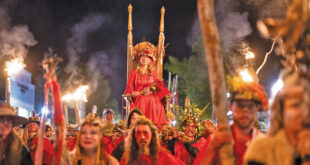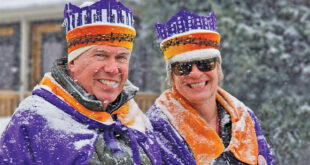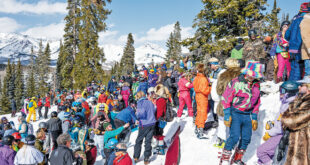by Dawne Belloise
Dr. Amy Ellwein analyzes the world from the top down, observing crags and outcrops, seeking answers far below the surface of earth, and based on whether sedimentary, metamorphic or igneous—along with other clues only a sleuthing geologist would know—paints a landscape of upheaval and seismic intrigue much like a violent murder mystery.
 She is, after all, Dr. Rock, and her excited animation is contagious when telling the story of how and when these mountains formed, where the bottom of millions-years-old oceans once were or where enormous calderas once blew up the Western Slope. Her expertise is as solid as the rocks she studies.
She is, after all, Dr. Rock, and her excited animation is contagious when telling the story of how and when these mountains formed, where the bottom of millions-years-old oceans once were or where enormous calderas once blew up the Western Slope. Her expertise is as solid as the rocks she studies.
Amy was raised in Minneapolis, where her father worked for Pillsbury as a patent and trademark lawyer, protecting the image of the Pillsbury Dough Boy, Poppin Fresh, from unauthorized use. As a kid, Amy spent all her time outdoors. In the winter, she was breaking trail, Nordic skiing in the swamp behind their house. “It’s Minnesota, land of 10,000 lakes and 100,000 swamps. Dad taught us to downhill ski when we were five years old but in Minnesota, it’s not really downhill skiing, it’s more like skiing down molehills on ice,” she remembers, and adds that, nevertheless, the family went skiing every weekend. In the summer, the family took advantage of the abundance of lakes and waterskied every weekend.
Amy confesses that throughout high school, she was a major troublemaker, mostly because she was bored. “I hated high school, so I skipped a lot of school. For me, there were too many rules and not enough intellectual challenge. And it was too cliquish. I didn’t fit neatly into the scene: square peg/round hole. I was a burn-out and a drop-out.”
When Amy was 15, her tenth-grade counselor gave Amy’s father a choice—she could either be expelled or be enrolled in college. In grade school, Amy had been placed in a gifted and talented program, identified as a kid who would benefit from additional challenge.
“I said expel me, but Dad said, ‘She’s going to college,’” Amy explains, and they enrolled her at Normandale Community College, taking science, math and engineering.
“I had decided at that point that I didn’t like people and reasoned that if I went into science I wouldn’t have to deal with them. I liked understanding the natural world outside of humans. I found us annoying. I wanted to understand nature. When I started, I thought I was going to hate it.” However, Amy immediately loved it.
“Science is very self-directed. To be a good scientist, you have to be objective, skeptical, but also open-minded. There’s a lot of paradox in science and a lot of room for creative expression within those rules. You have to be detailed-oriented at one level but you have to think about the global implication. It’s awesome. You’re putting together a lot of facts and ideas,” Amy says.
Amy became a dean’s list chemical engineering major, and only one semester away from graduating from college, she had a late revelation. “I became really uncomfortable with the engineering mindset that you can reduce the world to a series of equations. It was too black and white. It didn’t incorporate the grey that I knew the world was made of. The second thing came to me one day while I was sitting in a quantum chemistry class. Looking around the room, I started thinking, damn, if I graduate with this degree I’m going to have to work with these people. I don’t have a natural affinity for engineers; I like interesting people. All my best friends were rebels and misfits. They weren’t the engineering types.”
Amy had to do some serious and fast thinking, and she asked herself, “What is my all-time favorite science class? And it was geology. So I walked over to the geology building to check it out. It was the oldest building on campus—dusty and dirty and full of rocks and boxes and characters. Everybody there looked like me; they were all wearing flannel shirts, ripped-up Levi’s and all the guys had long hair. I was home. These are my people. As a geologist, you got to go camping, traveling, do science outside, and geologists drink a lot of beer.”
It took her an extra couple of years but Amy graduated in 1993 from the University of Minnesota with a bachelor of science degree in geology and geophysics.
According to Amy, it’s a common occurrence among field geologists to hook up in field camp, although most field camp romances supposedly dissolve below 5,000 feet in elevation. She met Tim Wawrzyniec, the mineralogy teaching assistant (TA) for the lab section in the fall of 1991 and the following summer he was the TA for an eight-week geology field camp in southwestern Montana.
“It was eight weeks of science all day, every day, and drinking all night, every night. It was a big old science nerd camp party,” Amy laughs, and the two rock nerds hit it off. After graduating in 1993, the couple went to the University of New Mexico together, Tim to work on his Ph.D. and Amy pursuing her master’s degree. “He asked me to marry him that year but I said, wait a minute, master’s before Mrs.” They married in 1997 after she received her master’s degree in soil geomorphology.
A big chunk of Tim’s dissertation research was on the Elk Range thrust, and as his field assistant, Amy first came to Crested Butte with him in 1994.
“We had been doing work on the Aspen side so my first view of Crested Butte was coming over from Kebler Pass. From 1994 to 1999 we’d spend one to three months a year living out of a Jeep doing geology work,” Amy says, and it was during those summer months out in the wilderness that they decided they wanted to live here.
Unfortunately, the geology department at Western State College (WSC) seemed stable with no one looking to retire in the near future, so Tim took a job as a petroleum geologist in Houston. They loved the high country and weren’t thrilled about having to live at sea level but, in their innovative, twisted geo-minds, they reasoned that by living northwest of Houston, where the ancient beach used to be during the ice ages, they could still be close to the mountains—in essence, since all that sand came from the Rockies.
Amy lasted less than a year before she offered her husband an ultimatum: “I’m leaving Houston. I hope you join me.” They found jobs in a city more conducive to their lifestyle, Austin, where Amy was employed as an environmental consultant and Tim became a research professor at the University of Texas in Austin. “Austin was way better because there was really good food and music and it was a fun town, and there were rocks in the hill country.”
In 2003, Amy decided it was time to get her Ph.D., and they headed back to the University of New Mexico. She graduated in 2011.
While in New Mexico, Amy and Tim started the Lidar Lab, initially for geologic research, but it later morphed into Lidar Guys when they got a call from the movie production company that was making The Book of Eli. Lidar, which is an acronym for light detection and ranging, works like radar or sonar, only using laser light in a scanning and measuring process. With New Mexico’s tax-break incentives for filmmakers and the movie industry, Lidar Guys was born, because the movie companies pay a lot more than academics, Amy noted.
Amy explained, “In simple terms of application, you’re scanning an object and building it in a high-resolution 3D photo. You can scan whole landscapes, people, small and large objects, and then using green screen technology, you’re building CG reality. We scanned the entire canyon to use in the film Cowboys and Aliens. The scan then goes to the computer graphic guys and they make the CG alien run through that scanned canyon and it looks like they’re running through the real canyon. It’s amazing what they can do. We’re basically just taking pictures and handing the scans to them. For The Hunger Games, where the buildings in Chicago are bombed out, we scanned those buildings then handed the images to the 3D CG artists and they make it looked like it’s bombed.”
Lidar Guys worked on two of The Hunger Games films, The Last Stand and both Maze Runner movies. The couple continued to do geologic and engineering application, but Amy laughs, “It’s not as much fun to talk about.”
In 2010, they were finally able to realize their dream of moving to the Gunnison Valley when Tim took a tenure-track job at WSC and Amy got a post-doctoral position at Rocky Mountain Biological Labs (RMBL) with Ian Billick. The National Science Foundation funded the project of turning long-term data sets into college-level curricula.
Amy says, “We had Tim’s job, my job, Lidar Guys and SEIS,” Science Education Institute of the SW, a nonprofit for education started by Amy, that trained biology and geology teachers to think like field scientists. She became an adjunct at WSC, teaching science courses for education majors.
In the midst of the happy chaos, in the spring of 2011, Tim was diagnosed with brain cancer, which resulted in a Flight for Life to Denver for emergency brain surgery, but after the surgery, Tim went back to teaching at WSC. “He fought like hell and we spent every minute outside, enjoying this place from skiing to hiking in the Church of the Great Outdoors.”
But everything got very complicated for the couple with multiple procedures, two major brain surgeries, and two temporary relocations to Denver during those treatments. Tim fought on, taking a job with Antero Resources in Denver in spring of 2014 after his second brain surgery. Amy was named director of science education at RMBL, working remotely during the winter to be with Tim in Denver and commuting between Crested Butte and Denver in the summer.
With Tim’s condition worsening in early October 2014, they chose to move to Denver, and having just moved all their belongings, they were told Tim needed to go into hospice. They had barely unpacked, and they moved everything to Amy’s family’s house in Minneapolis. Tim passed away November 6, 2014.
Amy says, “So, I find myself in Minnesota with half my stuff, the other half is in a house we owned in Denver. I have a job in Crested Butte that I love and I’m now the head of our company in Albuquerque. Now what?”
Amy was still in shock and grieving. She bought a house in Albuquerque with her mother to manage Lidar Guys from, sold the house in Denver, and bought a duplex in Crested Butte with her two brothers. Her youngest brother, Andy, moved into the other side last spring. For the next two years, Amy held a traveling wake for Tim, hitting the many places they had lived and revisiting all the friends they had.
Amy continues her work at RMBL as director of science communications and engagement. “Which means I connect our scientists with the world, and the world with our scientists. Scientists are busy, they don’t always have time to translate their science for the public.”
Amy explains that one of her jobs is to create science interactions and public outreach by engaging scientist led tours, public talks and events. As more of a storyteller, she helps translate science into ideas everyone can understand. She also trains the staff and docents at the informative visitor’s center in Gothic—she says they’re always in need of more volunteers. “This summer will see a new opportunity for tourists and locals with geology van tours that will leave from the Four-way Stop downtown.”
Amy is super-excited about the new event. “I love leading geology tours. The tours will probably involve another expert in biology or history. It’s still in the planning stages.”
Because of the difficult and tumultuous emotional circumstances of the past few years, Amy has a profound respect and love for her chosen home in Crested Butte and she feels it’s all about community. “Coming back here after Tim died, it struck me even harder that people were here for me. People were super-supportive when Tim was sick and that blew me away.” She smiles and acknowledges, “It’s so easy to constantly be surrounded by the Church of the Great Outdoors.”
For more information on events and schedules for the Rocky Mountain Biological Labs, located in Gothic, visit their website at RMBL.org.
 The Crested Butte News Serving the Gunnison Valley since 1999
The Crested Butte News Serving the Gunnison Valley since 1999




